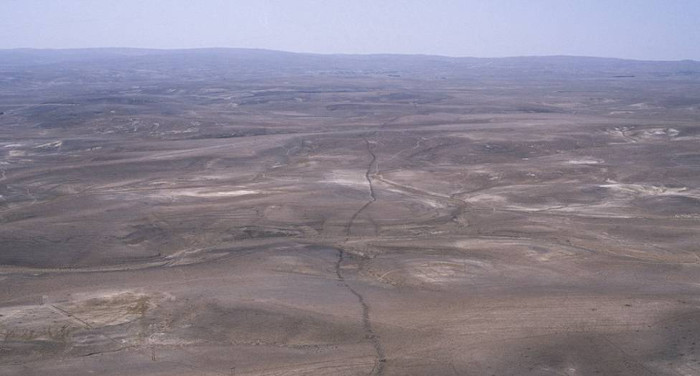The school is mysteriously cutting Jordan off
By aerial photography, archaeologists in Jordan obtained a picture of a 150km-long wall that brought great mysteries about time, purpose and builders.
According to Live Science, the ancient wall of Khatt Shebib was first discovered in 1948. Alec Kirkbride, a British ambassador to Jordan, discovered the mysterious stone wall that cut across the country during a machine trip. fly.
Through Jordan's aerial archaeological project (AAJ), researchers looked at the remains of the wall using aerial photography. The ancient wall follows the direction from North - Northeast to South - Southwest, with a total length of 106 km, including many parallel walls and branch segments.
"If we add the length of branches and parallel wall segments, the actual length of the wall can be up to 150km," the team said in the February issue of the Zeitschrift für Orient-Archäologie.

Cross-sectional Jordan image taken from above.(Photo: Robert Bewley).
According to the study author, the wall was destroyed, but at first it could not be more than a meter tall and more than half a meter wide.
Along with Khatt Shebib, archaeologists also found traces of 100 diameter towers from two to 4 meters. Some towers were built after the wall was completed, for different purposes. Some use for refuge at night or watchtower. Other numbers are used by hunters to track their prey until they come close enough to shoot down.
So far, the time, purpose and builder of the wall is a mystery. The only information that scientists gain is from pottery found in towers and some points along the wall. According to ceramic analysis results, the wall was built around the middle of Nabatea period (from 312 BC to 106) and the Umayyad period (year 661-750).
Most likely the wall is not built by a large empire."It is possible that the local population observed the neighboring community building walls. They were convinced of its usability so they copied it," said David Kennedy, a professor at the University of Western Australia, the lead author of the study. , identify.
The wall is quite low and narrow, so it cannot serve defense purposes. The ancient agricultural trail on the west side of the wall indicates that the building may be the boundary between farmers and nomads.
- Student He found the best way to make chips
- It turns out we all wash the cutting board the wrong way
- Wooden cutting boards are proven cleaner than plastic cutting boards
- Beautiful creative paper cut art like fairy
- You can know the height and strength of a person by hearing them scream
- School for British nobility: Being like a fairy but suffering is more than a normal school
- Chicken quarry cutting - Measures should be applied in industrial animal husbandry
- Impressive salt crystals in the Dead Sea
- Impressive weather photos
- The holy river is about to die
- You will immediately remove the cleaning board with dishwashing liquid after knowing this
- The danger of 'death' stalks from using plastic cutting boards
 Discovered an ancient centipede fossil 99 million years old
Discovered an ancient centipede fossil 99 million years old Discovered bat-like dinosaurs in China
Discovered bat-like dinosaurs in China Discovered a 200-year-old bronze cannon of the coast
Discovered a 200-year-old bronze cannon of the coast Discover 305 million-year-old spider fossils
Discover 305 million-year-old spider fossils